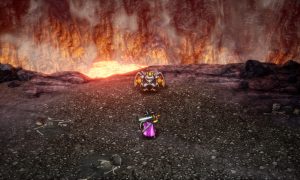I asked my 13-year-old son who Amerigo Vespucci was. He didn’t know.
Darned American public schools.
Perhaps in my kid’s mind the variant spelling of the Portuguese cartographer/explorer’s name caused a disconnect to the good ol’ United States Of, but still. Then leave it to the Germans at Queen Games to beat us corn-fed, beef-eating Americans to publishing a board game about our country’s namesake. Then witness us beaten at our own game of soliciting investment money, since Queen took the game Amerigo to Kickstarter to fund it, which happened faster than the bull ride of a bad rodeo cowboy.
Wake up, America!
Maybe the nation named after Amerigo Vespucci ain’t what it used to be, but what about the game?
I think they buried Vespucci inside the box
The MSRP for Amerigo is around $75, and judging by the immensity of its box, you’ll feel like you’re getting your money’s worth in components (though more about that later).
[singlepic id=17996 w=620 h=350 float=center]
For the player group:
- 1 cube tower (mostly pre-assembled)
- 49 wooden cubes (seven colors of seven each)
- 1 tracking board with actions
- 16 island board tiles
- 8 locking frame pieces
- 37 neutral landscape tiles
- 24 progress tokens
- 50 production tokens
- 40 commodity tokens (eight each of cotton, tobacco, coffee, coconut, sugar cane)
- 6 pirate markers
- 5 wooden treasure chests
- 4 time markers
- 1 planning token
- 1 rulebook
For each of up to four players (total equals number shown times four):
- 1 player board
- 16 village tiles
- 12 wooden trading posts
- 2 wooden ships
- 5 wooden scoring, victory, or player order discs
- 2 victory point tiles
Amerigo is a cardboard lover’s dream. Set aside a half hour just to punch out the pieces and sort them.
As is true with all Queen games, component quality is excellent. Because the company prides itself on making games for gamers, Queen includes several sealable plastic bags for bagging components. They don’t have to, but they do (hint, hint to other game publishers).
The playing board of Amerigo is modular, which provides randomness and helps replayability. Queen again goes the extra mile and includes a frame for the large board tiles so they don’t slide around.
The game pieces are a manageable size with clear graphics, even if the soft pastel background colors used to separate pieces can be hard to distinguish in poor light.
Nothing prevents flop sweat at the thought of wading into several hundred pieces of cardboard like a good rulebook. Amerigo’s is clear, concise, easy to read, and has excellent examples of play amid a layout that makes finding answers a breeze. You won’t be left frantically paging through the rulebook while everyone stares daggers at you for trotting out a game with three bazillion pieces. I’ve never played a Queen game that forced me to flee to some online FAQ or errata to clear up a question. Every board game publisher should look to Queen as the model of doing a rulebook right.
“Excuse me, I’m looking for a continent…”
Amerigo’s clear rulebook is a good thing since the rules took almost a half hour to explain to my game group, even with my summarizing. The basic gist:
Up to four players will use their two ships each to explore island regions, colonise them, build trading posts and other buildings, collect resources, find a buried treasure or two, and fight off looting pirates. Players can gain advantages by gathering progress tokens that will boost their capabilities.
To accomplish their missions and secure the most victory points, players must best manage eight types of actions in each phase of the game. Amerigo plays in five “year” rounds. Each year consists of phases of actions performed in order. The actions below—save for taking gold—are each represented by seven wooden cubes per color (49 total)::
- Move ships (blue)
- Load cannons (black)
- Plan island building (red)
- Progress in capabilities (brown)
- Build on islands (green)
- Buy production tokens (yellow)
- Take special actions (white)
- Get gold (not a separate phase, always an option in place of the above)
Each player has an individual player board to track gold, progress, commodities, and cannon munitions. In addition to these and to the main island playing board, another board tracks action phases. pirates, progress and production tokens available, and scores.
[singlepic id=17995 w=620 h=350 float=center]
The component of the game that makes Amerigo distinct is its cube tower.
Cube tower?
What it’s similar to is the more familiar dice tower, an upright “silo” with angled baffles on the inside that randomize dice as they are poured through the top and roll down through the tower, all dice exiting the bottom.
A cube tower uses the same principle, except level baffles hold back a few cubes between pours. What comes through isn’t always what was put in, randomizing the output.
To start the game, all 49 colored cubes are poured through the cube tower. Any cubes not retained by the tower are sorted on the tracking/action board into their respective colors. Play consists of phases of pouring one color through the tower, basing the actions for that phase on the colors that come out. The color with the majority number of cubes sets the number of action points available for that one phase.
Example:
It’s the planning phase (red). Six red cubes are available to pour; one must still be inside the tower. Pouring the red cubes through yields four red, two black, and one yellow that exit the tower. Even though the phase is planning, the black and yellow cubes that exited with the red allow for loading cannons or buying production tokens. Because the majority color was red in the amount of four, each player can take actions that amount to four actions points in planning, loading cannons, or buying production tokens. If four action points aren’t enough to plan to build on a large section of island that requires five action points, whatever gold a player may have secured (always an option to take instead of one of the other types of actions) can be used to “buy” additional action points for that player.
The phases:
Blue moves allow players to sail to islands, dock, and set up a trading post. A player can only perform actions on an island if he or she has a trading post on it. The number of trading post on an island is limited, so this can be used to lock other players off an island.
Black cannon loading means cannonballs for fighting pirates. Pirates will patrol the seas and any player who lacks the cannon shot to repel them all at year end will suffer losses. Track this on the player board.
Red planning allows a player to use action points to grab puzzle-like village and landscape tiles to place on an island during a building phase.
Brown progress will garner technology to improve a player’s chances to meet goals. These effects may be single use, permanent use, or count only during final scoring. Cannon fire might become more effective. A ship might sail farther. Any action might be more efficient, gaining an action point. Adding a trading post might mean getting gold with it too. In addition, each player board has a progress track; move further along it and score more points. Store progress tokens there too.
Green building allows players to take the village or landscape tiles gained in the red planning phase and place them on islands. Any of the five types of commodities shown on the island covered by a village or landscape tile will net that commodity for the player, which is then tracked on the player’s board.
Yellow production provides multiplier tokens for existing commodities a player accumulates. Multiply the the count of the production tokens gained by the commodity tokens count at game’s end for more victory points.
White special action lets players alter their turn order on the special action track. Or a player can force a particular type of action to happen in a phase even if that action did not happen through the cube tower result.
Again, if a player prefers to get gold instead, any phase result can be converted to gold: Divide the majority cube color from the pour by three and round up.
First player to complete an island through building gets bonus points. A large island completed also grant a treasure chest of bonus points to the player who completes it. Gold at the end of a game counts as 1:1 points. Commodities and their production multiply to score. Progress scores. Some progress tokens will boost final scores. The special actions track scores.
Score, score, score!
Sweet, sweet booty–of the treasure variety
Amerigo was designed by Stefan Feld, who had a banner 2013, releasing four notable games. Feld’s style is often referred to as “point salad,” since he gives players almost too many ways to score points. While this can lead players to puzzle over a winning strategy, the many options keep the game fresh for adventurous players willing to experiment. This keeps replayability high.
Just as many ways to score points exist, the game features a number of different gaming mechanisms. Players collect sets of commodities. They plan and lay puzzle-piece-like village and landscape tiles. They optimize moves, account for enemies, box out other players through area control, and on and on. With so many different types of game mechanisms, no one player who is best at any one mechanism should get the upper hand.
Amerigo’s cube tower adds a fascinating randomization mechanism found in few games, most notably Queen Games’ Wallenstein and Shogun, both of which used it as a battle determination mechanism. When the cube tower delivers unexpected results, it can be a maker or breaker for a player. “What will come out? Will I get what I need?” Definitely exciting!
The quality of the game is hard to argue against. On the table, it’s engaging to see. While the MSRP is high at around $75, the box is packed with goodness.
And I’ll note it again: Superb rulebook.
“Uh, Mr. Vespucci, you just sailed off the edge of the planet…”
For all those positives, Amerigo has problems.
The game can be swingy. I played two sessions that could not be more dissimilar.
One was tense, with heartbreaking or joy-making results from the cube tower that made our adrenaline surge with every cube pour. Big pirate numbers and a player with the “add two pirates” token made planning for raids critical, which meant balancing everything else was a challenge. That session was great!
The other session gave predictable, boring results from the tower, while also offering mostly unusable progress tokens early in the game. In addition, few pirates plundered, so planning to defend against raids was a waste. One player boxed out out another player from getting to islands, which effectively took that harborless player out of the game, forced to mark time until the game’s end almost two hours later. That session was meh.
So, the game’s DNA contains outcomes for something wonderful or for a doomed, mutated mess. Sure, experienced Amerigo players might mitigate some mess given the game’s Feldian point salad nature, but still.
Should a player get a rocky start, the game doesn’t feature many means to overcome, especially if failing to establish trading posts is the problem. This can lead to both a runaway leader and a “runaway” loser. Yes, the pirates can be a small equalizer, but the game needs another catch-up or confrontative mechanism. Perhaps a future expansion might address this lack. Scurvy, anyone?
Apart from the cube tower, little else in the game rises above the average Eurogame. I kept feeling like I’d played Amerigo before.
This leads to a glaring negative. Despite all it has going for it, Amerigo is a $50 gaming experience with a $75 price tag. Translation: It’s not a good value. When the cube tower presents interesting results and the token randomization does too, it may be worth $75. But on average, the ROI isn’t there, and that’s disappointing. You might be able to get more enjoyment out of a $25 game of The Resistance: Avalon or a $10 Love Letter session than from Amerigo. Even Stefan Feld’s most acclaimed game, The Castles of Burgundy, often comes in under $25 street.
Francis Drake is a recent game with a similar pre-17th century nautical equipping, production, and battling theme, and while it costs $5 more than Amerigo, it feels like three times the game. Its components beat Amerigo’s in quality, too, which is an accomplishment. Though that game from Eagle Games and Kayal Games is between printings as of this writing, if you want what Amerigo offers in theme, Francis Drake far excels.
[singlepic id=17997 w=620 h=350 float=center]
But that cube tower!
Yeah, yeah, yeah, the cube tower. When it works, it’s fun. When it doesn’t, it’s dull. Sadly, Amerigo, for all its solid designer pedigree and fine components, is more of an average game than it should be, especially considering its cost.
Game Name: Amerigo
Designer:Stefan Feld
Publisher: Queen Games
Year: 2013
Players: 2-4
Ages: 10+
Play time: 90 minutes (about 30 minutes per player)
Mechanics: Modular board, Tile placement, Area control, Grid movement, Cube tower-based action determination
Weight: Medium-Heavy – “Has a lot of rules, but they make sense and are easily learned”
MSRP: $74.99***
Freelance writer, editor, marketer, and more. Enjoy birding, geocaching, reading, drumming, and of course, board gaming.
Been playing board games since the 1960s. Have owned all the classics--Dark Tower, Bermuda Triangle, PanzerBlitz, Fireball Island, Magic Realm, and more. Got into RPGs with D&D and AD&D back in the late 1970s.
Today, I'm primarily a Eurogamer, and I play a little Pathfinder. Favorite games include: Tzolkin: The Mayan Calendar, Airlines Europe, 7 Wonders, Power Grid, Lords of Waterdeep, Seasons, Puerto Rico, and Hanabi.

Amerigo looks great, comes from a notable designer, offers many ways for players to win, and features an interesting randomization mechanism in its cube tower. Yet its variable play experience is more like a $50 game than a $75 one, which makes Amerigo a questionable value for those looking for the most bang for their gaming buck.
PROS
- Cube tower!
- Many pathways to victory
- Queen’s typically outstanding rulebook and components
CONS
- A high MSRP for the game play delivered, not a good value
- Too much randomization for some gamers
- Some sessions will be great, but others...
See below for our list of partners and affiliates:

























